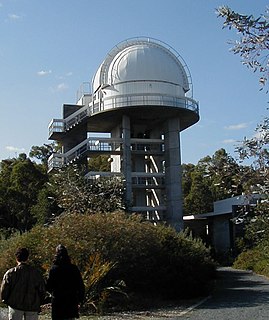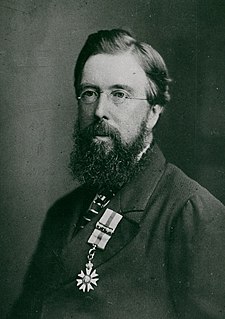
Sir John Forrest was an Australian explorer, the first Premier of Western Australia and a cabinet minister in Australia's first federal parliament.

Alexander Forrest CMG was an explorer and surveyor of Western Australia, and later also a member of parliament.

The Perth Observatory is the name of two astronomical observatories located in Western Australia. In 1896 the original observatory was founded in West Perth on Mount Eliza overlooking the city of Perth. Due to the city's expansion the observatory moved to Bickley in 1965. The new Perth Observatory is sometimes referred to as Bickley Observatory.

Sir Charles Todd worked at the Royal Greenwich Observatory 1841–1847 and the Cambridge University observatory from 1847 to 1854. He then worked on telegraphy and undersea cables until engaged by the government of South Australia as astronomical and meteorological observer, and head of the electric telegraph department.

The Sydney Observatory is a heritage-listed meteorological station, astronomical observatory, function venue, science museum, and education facility located on Observatory Hill at Upper Fort Street, in the inner city Sydney suburb of Millers Point in the City of Sydney local government area of New South Wales, Australia. It was designed by William Weaver (plans) and Alexander Dawson (supervision) and built from 1857 to 1859 by Charles Bingemann & Ebenezer Dewar. It is also known as The Sydney Observatory; Observatory; Fort Phillip; Windmill Hill; and Flagstaff Hill. It was added to the New South Wales State Heritage Register on 22 December 2000.

The land border of the State of Western Australia (WA) bisects mainland Australia, nominally along 129th meridian east longitude. The border divides WA from the Northern Territory (NT) and South Australia (SA).
The Kalgoorlie Miner is a daily newspaper circulating in the City of Kalgoorlie-Boulder and the Goldfields-Esperance region, in Western Australia.

The Australian and New Zealand Association for the Advancement of Science (ANZAAS) is an organisation that was founded in 1888 as the Australasian Association for the Advancement of Science to promote science.

Mount Cooke, near Jarrahdale, Western Australia, is one of the highest points on the Darling Scarp at 582 metres (1,909 ft). It was named after William Ernest Cooke, Western Australia's first Government Astronomer.

The Mills Observatory in Dundee, Scotland, is the first purpose-built public astronomical observatory in the UK. Built in 1935, the observatory is classically styled in sandstone and has a distinctive 7 m dome, which houses a Victorian refracting telescope, a small planetarium, and display areas. The dome is one of two made from papier-mâché to survive in the UK, the other being at the Godlee Observatory.

William Ernest Cooke, generally referred to as W. Ernest Cooke or informally Ernest Cooke, was an Australian astronomer, credited with a number of important scientific breakthroughs and improved methodologies in astronomical observations and star cataloguing. He was the first Western Australian Government Astronomer and established the Perth Observatory as one of the best equipped and productive establishments of its type in Australia.
William Garnsworthy Bennett was a Western Australian architect, well known for his Art Deco and Inter-War Functionalist style of civic, commercial and domestic buildings, including the Lord Forrest Olympic Pool in Kalgoorlie, the Beverley Town Hall, the Raffles Hotel and Plaza Theatre and Arcade in Perth.

The Hon Septimus Burt KC was a Western Australian lawyer, politician and grazier, the son of Sir Archibald Burt.
Ebenezer Cooke was a South Australian accountant, Member of Parliament and Commissioner of Audit.

Richard William Pennefather was the ninth Attorney-General of Western Australia, its third since Responsible Government. He served two terms as Member of the Legislative Assembly for Greenough; was Acting Justice of the WA Supreme Court (1901–1902); then was elected to the Legislative Council for North Province in 1908. He died in office on 16 January 1914.

Harold Burnham Curlewis was an Australian astronomer. He was Acting Government Astronomer and Meteorologist in Western Australia from 1912 until his appointment as Government Astronomer in 1920. He held that position until 1940 and is credited with keeping the Perth Observatory open in face of government opposition. The asteroid 3898 Curlewis is named in his honour.
Michael Francis Cavanagh was an Australian architect, primarily known for his work in Western Australia from 1895 to the late 1930s.
James Charles Cavanagh was an Australian architect, primarily known for his work in Western Australia and Queensland.
William John Hancock D.Sc. (Hon), MIEE, MICE, LRCP was an Australian of Irish descent, an electrical engineer, telephone pioneer and pioneer in X-rays in the colony of Western Australia. He was honorary radiologist for Perth Hospital and Base Hospital in Fremantle. His list of credentials and accomplishments include M.I.E.E., Member of the Institution of Electrical Engineers, M.I.C.E., Member of the Institution of Civil Engineers, L.R.C.P., Licentiate of the Royal College of Physicians and D.Sc. (Honorary).
Andrew Arthur Wellesley Wilkie was director of Melbourne Zoo from 1923 to 1936, and closely associated with that institution for 70 years. He was a major influence on the planning and development of Perth Zoo.